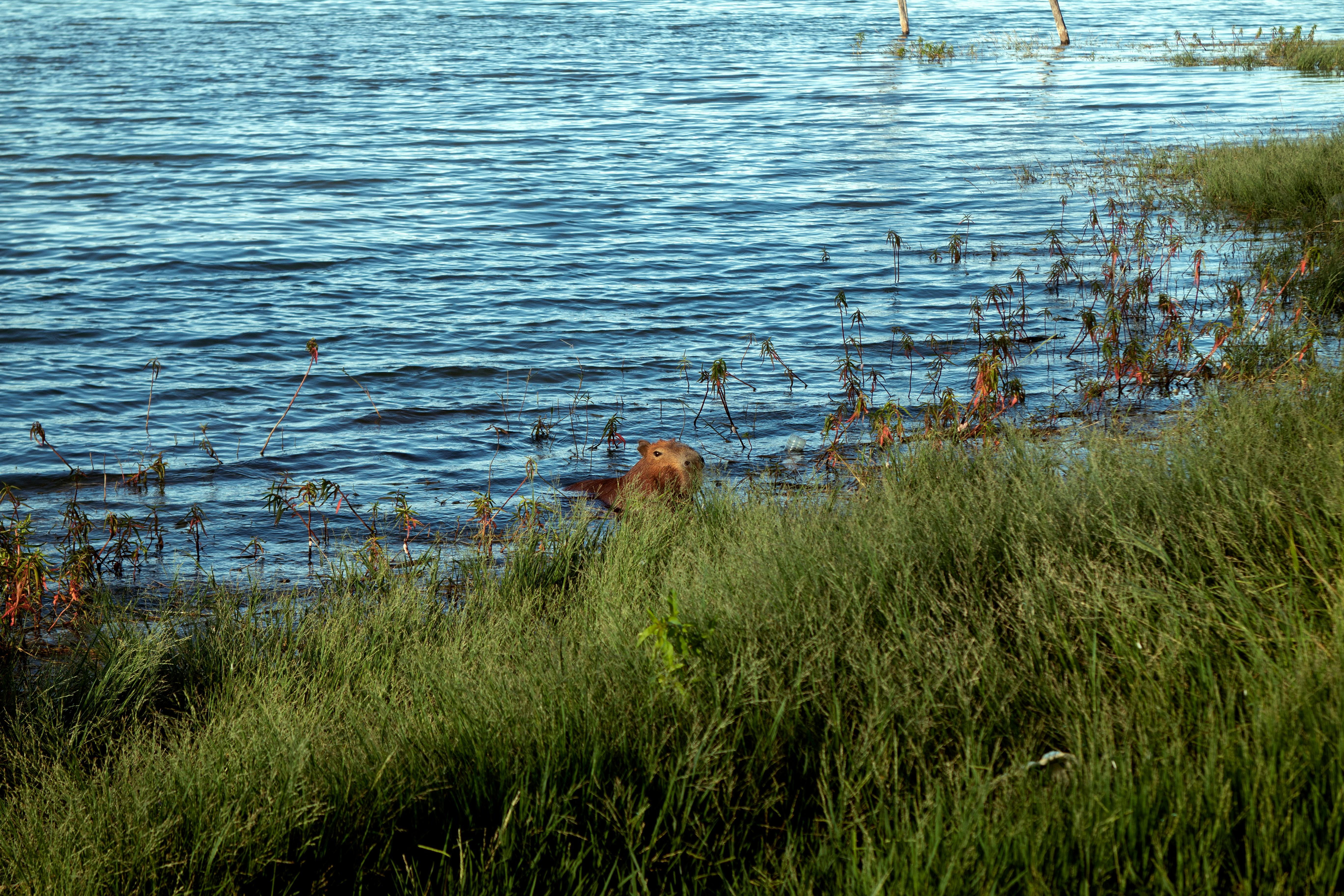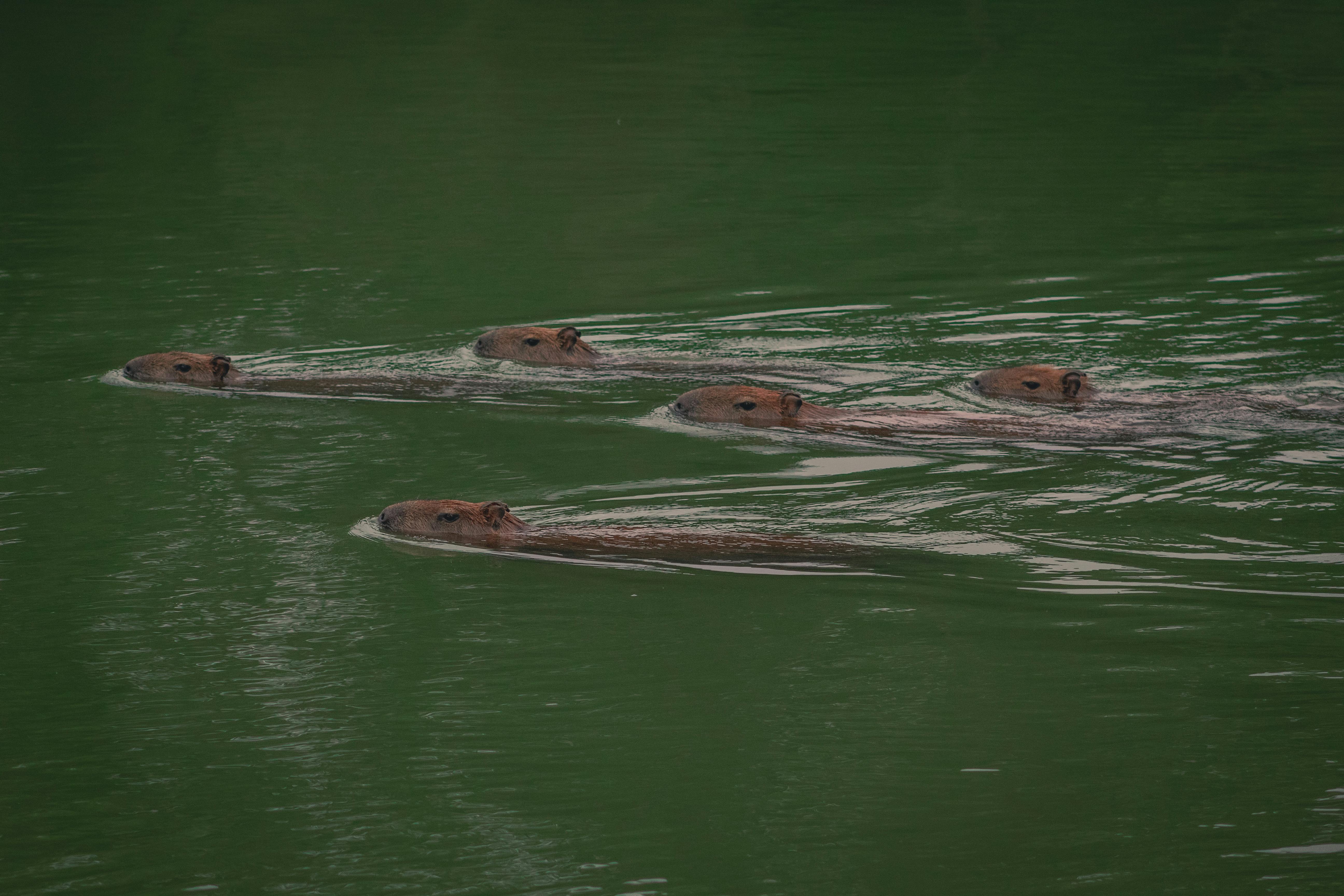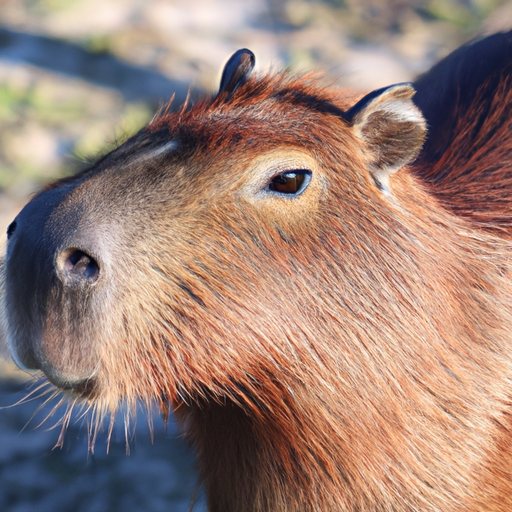Florida is not only known for its beautiful beaches and warm weather, but also for its diverse wildlife. One creature that has captured the attention of many is the capybara. These fascinating rodents, native to South America, have found a home in certain parts of Florida. If you are curious about where these adorable creatures can be found within the state, this article will shed light on their whereabouts and provide an insight into the unique habitats they inhabit. So, put on your explorer’s hat and get ready to discover the captivating world of capybaras in Florida.

Overview
Capybaras: An Intriguing Species
Capybaras, known for their friendly and sociable nature, are fascinating creatures that have found their way to the sunny state of Florida. As the largest rodent species in the world, they capture the curiosity and interest of both locals and tourists alike. In this article, we will explore the origin and habitat of capybaras, their adaptability to Florida’s climate and natural landscapes, as well as their presence in various regions across the state. Additionally, we will delve into conservation efforts and address concerns regarding their impact on Florida’s ecosystems.
Importance of Identifying Capybara Habitats in Florida
Understanding and identifying capybara habitats in Florida is crucial for various reasons. Firstly, it allows us to gain insights into the natural landscapes that sustain these unique creatures. Additionally, identifying their habitats enables wildlife researchers and enthusiasts to study capybara behavior, population dynamics, and their impact on the ecosystems they inhabit. This knowledge can contribute to effective conservation efforts, ensuring the coexistence of capybaras and other native flora and fauna in the region.
Origin and Habitat
Native Range of Capybaras
Capybaras, scientifically known as Hydrochoerus hydrochaeris, have their roots in South America, particularly in the countries of Brazil, Venezuela, Colombia, and Argentina. They have long been an integral part of the region’s diverse ecosystems, often found near bodies of water such as rivers, swamps, and marshes. Within their native range, capybaras thrive in a variety of habitats, adapting to both tropical rainforests and savannah grasslands.
Introduction of Capybaras in Florida
The introduction of capybaras in Florida is attributed to various factors, including intentional releases and accidental escapes from captivity. It is believed that some individuals sought to establish them as exotic pets, while others simply could not contain these semi-aquatic creatures within their enclosures. Regardless of the reasons behind their presence, capybaras have managed to establish themselves in certain regions of Florida, where they have found suitable habitats and abundant resources.
Prevalence of Capybaras in Florida
Capybaras can be found in several regions across Florida, particularly in areas that provide the necessary freshwater habitats and suitable climate conditions they require to thrive. While their numbers are difficult to estimate accurately, there have been numerous observations and encounters reported by residents, wildlife enthusiasts, and researchers. In the following sections, we will explore some of the notable areas where capybaras have been observed, highlighting the unique characteristics of each region.

Climate and Natural Landscapes
Suitable Climate for Capybaras in Florida
Florida’s warm and humid subtropical climate provides an ideal environment for capybara habitation. The state’s long, hot summers and mild winters create a year-round favorable climate for these large rodents. With an abundance of rainfall and temperatures rarely dropping below freezing, capybaras can thrive in Florida’s unique climate, reproducing and establishing stable populations in suitable habitats across the state.
Capybara Adaptability to Freshwater Habitats
As semi-aquatic mammals, capybaras have a strong affinity for freshwater habitats, making Florida’s extensive network of rivers, lakes, and wetlands perfect for their survival. From the vast marshes of the Everglades to the tranquil swamps and lagoons scattered throughout the state, capybaras can find ample water sources to swim, forage, and escape predators. Their physical adaptations, such as webbed feet and the ability to stay submerged for several minutes, further enhance their adaptability to these freshwater environments.
Predominant Natural Landscapes Sustaining Capybaras
Florida boasts a diverse range of natural landscapes that sustain capybara populations. In the southwest region, the Corkscrew Swamp Sanctuary serves as a haven for wildlife, including capybaras, with its iconic cypress forests and extensive wetlands. Moving towards central Florida, the Orlando Wetlands Park offers a unique opportunity to observe capybaras in their natural habitat, surrounded by marshes, ponds, and grassy fields. In the southeast, the Wakodahatchee Wetlands and Loxahatchee National Wildlife Refuge provide sanctuary to these fascinating creatures amidst palm hammocks, marshes, and diverse waterfowl habitats. Lastly, in the north, the Osceola National Forest and Ichetucknee Springs State Park are known to harbor capybaras amongst their pristine forests, lakes, and crystal-clear springs.
Southwest Florida
Capybaras in the Corkscrew Swamp Sanctuary
The Corkscrew Swamp Sanctuary, located near Naples, is an exceptional landscape that attracts numerous wildlife species, including capybaras. Visitors to this protected area can witness capybaras basking in the sun along the boardwalks that meander through the cypress forests and wet prairies. The sanctuary’s vast wetlands, fed by the Corkscrew River, provide an ideal habitat for capybaras to thrive, making it an excellent location to observe these unique creatures in their natural environment.
Exploring the Capybara Population in Jonathan Dickinson State Park
Situated in Hobe Sound, Jonathan Dickinson State Park is home to a thriving population of capybaras. This scenic recreational area offers visitors a chance to witness capybaras grazing along the banks of the Loxahatchee River or bathing in the park’s numerous freshwater ponds. As one of the largest state parks in southeast Florida, Jonathan Dickinson State Park combines lush forests, riverine habitats, and wetlands, creating a perfect refuge for capybaras amidst the region’s natural splendor.

Central Florida
Encounters with Capybaras in the Orlando Wetlands Park
Exploring the Orlando Wetlands Park provides an opportunity for unforgettable encounters with capybaras. This expansive 1,650-acre reclamation facility features an intricate network of marshes, lakes, and canals – an ideal environment for capybaras to thrive. The park’s open vistas and diverse plant life offer a picturesque backdrop as visitors catch a glimpse of these intriguing creatures navigating through the wetlands and engaging in their social behaviors.
Observing Capybara Behavior in Lake Kissimmee State Park
Lake Kissimmee State Park, located in Polk County, is another remarkable destination to observe capybara behavior in their natural habitat. The park’s sprawling lake, wet prairies, and floodplain forests provide an inviting space for capybaras to dwell. Visitors can witness capybaras foraging in the grassy fields or taking leisurely swims in the lake’s calm waters. Exploring the park’s trails and marsh boardwalks allows for an up-close and personal experience with these captivating creatures.
Southeast Florida
Capybaras at the Wakodahatchee Wetlands
The Wakodahatchee Wetlands, situated in Delray Beach, is a hidden gem teeming with wildlife, including a growing population of capybaras. This constructed wetland complex, renowned for its proactive approach to water treatment, features an intricate series of ponds and marshes. Amongst the cattails and waterlilies, capybaras can be spotted lounging on the banks or gracefully swimming across the expanses of water, offering visitors a rare opportunity to observe their behavior and interaction with the surrounding environment.
Spotting Capybaras in the Loxahatchee National Wildlife Refuge
The Loxahatchee National Wildlife Refuge, a haven for diverse flora and fauna, is an excellent destination to spot capybaras in southeast Florida. This vast preserve, encompassing freshwater marshes, swamps, and tree islands, offers capybaras a multitude of habitats to inhabit. Visitors to this refuge may come across capybaras grazing in the grassy marshes, or perhaps catch a glimpse of them soaking in the cool waters, showcasing the adaptability of capybaras to this remarkable natural environment.
North Florida
Searching for Capybaras in the Osceola National Forest
The sprawling Osceola National Forest, located near Olustee, provides a unique opportunity to search for capybaras amidst the picturesque landscapes of north Florida. This forested expanse, dotted with numerous lakes, rivers, and swamps, presents an ideal habitat for capybaras. Venturing along the forest trails and waterways, visitors might encounter these fascinating creatures foraging near the water’s edge or bathing in the sun, showcasing the ability of capybaras to adapt and thrive in diverse natural environments.
Capybaras in the Ichetucknee Springs State Park
Ichetucknee Springs State Park, nestled in Fort White, offers a serene setting for both humans and capybaras. The park’s crystalline springs, shaded by lush canopies of cypress and oak trees, create an idyllic environment for capybaras to call home. Wandering along the peaceful trails, visitors may spot capybaras quietly grazing near the riverbanks or cooling off in the pristine waters. The harmonious coexistence of capybaras and the park’s natural wonders is a testament to the enchanting beauty of Ichetucknee Springs State Park.
Coastal Regions
Urban Capybaras along South Florida’s Waterways
In the coastal regions of South Florida, capybaras have surprisingly adapted to urban environments, often seen along waterways in residential areas. These enterprising capybaras have embraced the canals, lakes, and retention ponds that have become synonymous with the region’s suburban landscapes. Their ability to coexist with humans in these urban settings is a testament to their resilience and adaptability, captivating the hearts and curiosity of local residents and sparking intrigue among wildlife enthusiasts.
Capybara Sightings at Key Biscayne
Key Biscayne, a picturesque island located south of Miami, has become a notable destination for capybara sightings. The island’s lush vegetation, coastal mangroves, and wetland areas provide an inviting habitat for capybaras. Whether strolling along the beaches or exploring the nature trails, visitors have reported sightings of these charismatic creatures enjoying the island’s natural beauty. The cohabitation of capybaras and Key Biscayne’s unique coastal environment offers a remarkable glimpse into the multitude of habitats that capybaras can thrive in.
Conservation Areas and Reserves
Capybaras in the Everglades National Park
The crown jewel of Florida’s natural wonders, the Everglades National Park, is home to a significant population of capybaras. Spanning across 1.5 million acres, this sprawling wetland supports a multitude of species, including these charismatic rodents. Capybaras can be found basking in the sun along the park’s riverbanks, wading through the shallow waters of the sawgrass prairies, and seeking refuge in the dense mangrove swamps. Their presence in this iconic national park showcases their adaptability and highlights the importance of their conservation in maintaining the delicate balance of this unique ecosystem.
Conservation Efforts in Big Cypress National Preserve
Adjacent to the Everglades, the Big Cypress National Preserve plays a crucial role in capybara conservation efforts in Florida. This vast expanse of cypress swamps, prairies, and pinelands provides a pristine habitat for capybaras, enabling them to thrive alongside numerous other wildlife species. The preserve’s commitment to preserving the natural habitats of capybaras contributes to the long-term sustainability of their populations and ensures their continued presence within the beauty of Big Cypress.
Concerns and Considerations
Impacts of Capybara Habitation on Florida’s Ecosystems
While capybaras have become a beloved addition to Florida’s wildlife, their presence does raise concerns about potential impacts on the state’s ecosystems. Their grazing habits can substantially alter vegetation patterns, potentially impacting the diets and habitats of other species. Additionally, capybaras can introduce diseases and parasites that may have unintended consequences for native wildlife populations. Studying and monitoring the interactions between capybaras and the ecosystems they inhabit is essential for understanding these impacts and implementing appropriate management strategies to mitigate any detrimental effects.
Human-Capybara Conflict Resolution
As capybaras continue to establish themselves in various regions of Florida, occasional conflicts between humans and these large rodents can arise. Damage to crops, gardens, and property can occur when capybaras venture into urban and suburban areas in search of food and water. It is crucial for residents and wildlife officials to develop strategies to minimize such conflicts, including the construction of barriers, implementing humane relocation techniques, and raising public awareness about the importance of coexisting with these fascinating creatures. By fostering understanding and harmony between humans and capybaras, we can ensure the preservation and well-being of both communities in the diverse landscapes of Florida.
In conclusion, capybaras have found a unique place within Florida’s vibrant ecosystems. Their adaptability, sociability, and ability to thrive in diverse habitats have allowed them to establish themselves across the state. Whether exploring the stunning wetlands of southwest Florida, observing their behavior in central and southeast regions, or encountering them in the forests and coastal areas of north and south Florida, capybaras continue to captivate both residents and visitors. As we strive to coexist with these remarkable creatures, it is crucial to understand their habitats, mitigate potential ecological impacts, and foster peaceful relationships between humans and capybaras. By doing so, we can ensure the conservation of capybaras and the preservation of Florida’s unique natural heritage for generations to come.



